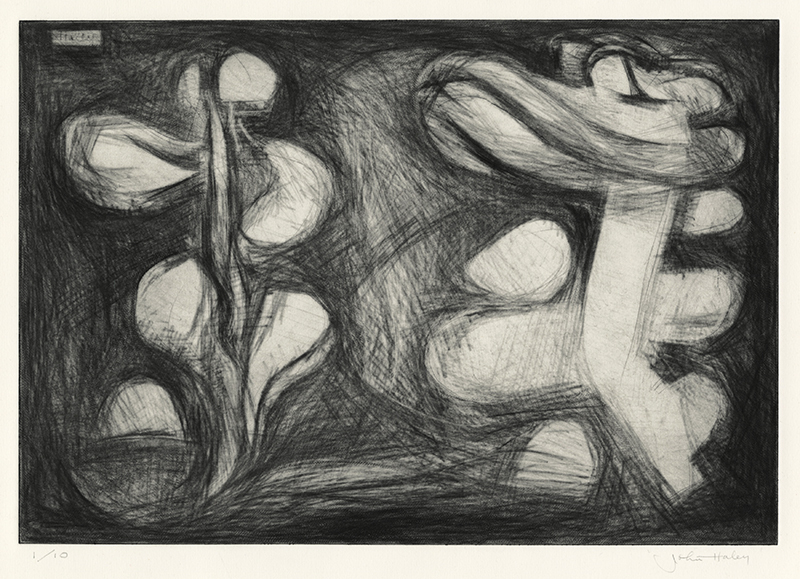
19th, 20th & 21st Century Fine Prints
707-546-7352 · fax 707-546-7924 · web: www.annexgalleries.com · email: artannex@aol.com
Untitled abstraction by John Charles Haley

Untitled abstraction
John Charles Haley
Untitled abstraction
John Charles Haley
1905 - 1991 (biography)Years of focus on tempera and watercolor painting led to an interesting dichotomy in John Charles Haley's style by the 1950s. With roots in conservative artistic training, it was a seminal trip in 1927 to Europe that changed his trajectory toward Modernism. However, a soft, nearly Impressionist attention to detail combined with bold, non-representational shapes and high contrast creates a harmonious Abstract Expressionist composition. Mezzotint was likely an appealing printmaking medium to Haley precisely for the ability to obtain painterly tonal values.
Like a number of other printmakers working in the post-war period, Haley printed only a couple of proofs in 1956, abstract works were generally not being exhibited nor purchased and editioning them seemed frivolous. Because they were experimental and not being done for a "market" they were often untitled. As the importance of these works became more understood the artists would go back and print small editions for their collectors. Such is the case with this composition, printed in a small edition of 10 in 1981 to benfit his foundation.
John Charles Haley was born in Minneapolis, MN on September 21, 1905. His earliest formal art studies began at the Minneapolis School of Fine Art in Saint Paul, studying traditional techniques and styles under Cameron Booth. This led to the commission of a portrait by and of lumber tycoon T. B. Walker, the founder of the Walker Art Center, who then nominated Haley for an Ethel Morrison VanDerlip fellowship to travel and study overseas upon graduation in 1927.
Haley embarked on his European visit that same year, accompanied by Booth. They traveled to Paris to visit various academic institutions, research contemporary art and artists, and to study with Andre Lhote. While there, they visited artist Vaclav Vytlacil, who had also taught at the Minneapolis School of Art. It was Vytlacil who recognized Haley's interest in Modernism and its various new offshoots, and encouraged him to study with German Expressionist Hans Hofmann, then teaching summer courses on the isle of Capri. Under Hofmann, both Booth and Haley were introduced to Cubism. Booth returned to Minneapolis while Haley stayed with Hofmann, following him to Munich to continue his studies. He would soon become one of Hofmann's most dedicated and outstanding students. This period clearly marked a major change in Haley's art, as he moved away from his conventional art roots into the burgeoning Modernist world.
The following year Haley returned to the U.S., traveling up the California coast and spent time with Vytlacil who was now teaching at the University of California, Berkeley - a momentous visit that cemented Haley’s desire to teach and to surround himself with Modernist artists. After marrying artist Monica Pheres, they settled in the San Francisco Bay Area in 1930 where Haley began his forty-two-year career as Professor of Art at the University of California, Berkeley. He continued to teach until his retirement in 1972.
Along with Hofmann and Glenn Wessels, Haley is credited with putting into motion a sea-change at the University of California Berkeley, bringing it out of the shadows of traditionalist art values and greatly expanding its standing as a hub for Modernist artistic study. On the heels of a hot debate regarding UC Berkeley's place in the American art world, Haley stated his position explicitly: “There is no quarrel between modern and classic art...Modern art....is tradition expressing itself in a new way.”
